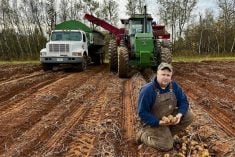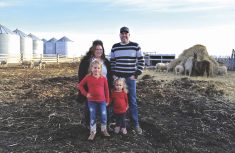At first, it seemed their real job would be to build awareness. What could have been clearer than that? After all, they had the idea already. Jacob van der Schaaf and his daughter, Angela Santiago, could see a market gap for the kind of small, flavourful potatoes that van der Schaaf had grown up with in Holland, and they had planted their trial acre of potatoes just outside of Edmonton.
It was 1996. Incredibly, the pair dug that first acre by hand. They even washed the baby spuds in a bathtub before taking test packs to some select restaurants and local delis, where they gave the samples to the deli owners for free just so they could get their feedback.
Overnight, van der Schaaf and Santiago knew they were on to a winner. And before the year was out, they had proof in the shape of an order from a single Alberta retailer who wanted their entire supply.
Read Also

Farmland values: assumptions and realities
Where farmland values are headed and what decisions farmers should make
They were on a roll. By 1998, The Little Potato Company had a staff of 30 and shelf space in supermarkets all across Western Canada.
Santiago, who would soon take over as CEO, felt like they were sitting on a powder keg, facing a new “how do we ramp this thing up” question almost every day.
And that’s just what they did. Today, the Little Potato Company is North America’s number one brand in the sector called creamer potatoes with 14,000 acres of contracted crop, 400 employees, and four plants, including a 95,000-square-foot facility in Edmonton.
Now the company is outgrowing that building too and construction is underway on an additional site built with sustainability in mind, i.e. solar panels that cover the roof and will generate almost enough power for year-round use, plus cutting-edge water conservation technology.
But there’s another side of the story because all through that growth process, van der Schaaf and Santiago had begun asking themselves a series of other questions as well, which turned out to be a very good thing and as important to the company’s future success as the little-potato concept itself.

Today, it’s Santiago’s advice to any new startup and especially for any farmer on the trail of a potentially big idea. The recommendation is clear: get strategic with your business thinking right from the start.
Don’t wait for threats. Don’t wait for the first competitor to come hunting for a slice of your market, or for a retailer to wonder if maybe you’re just a proverbial flash in the pan after all.
The benefits of getting strategic go way beyond the merely reactive. In fact, says Santiago, strategy is the key to your being able to flex your entrepreneurial muscles in the first place.
If that just sounds like biz speak, though, hold on. some of Santiago’s advice is flat-out surprising.
Below are seven key takeaways she has learned along the way, matched with the management insights they produced:
1. Know that your life is going to change.
In the beginning, Santiago knew every detail of the business, from the field to the customer’s stove top, and she leveraged that knowledge. But it had to change. On a personal note, Santiago reflects on how her life has changed from the early days of the company, “In the beginning, you’re doing a little bit of everything. I’ve learned as I’ve grown to find people that are way better at something than me and I can trust to actually lead …”
Her personal focus has shifted from the small details for the company to the overarching values and culture of Little Potato, and how this is having an impact on the work flow as a whole.
2. Know your objective.
For the Little Potato Co., the goal was to build a level of retailer and consumer preference that would see their trendy new product grow into a more stable mainstream business. But Santiago also learned another, more counterintuitive lesson. That’s to take things slow, one step at a time.
There was a point when the company tried to meet every consumer’s expectations, Santiago says, and this was an impossible thing to do.
She also learned it’s vital to understand and focus on what the business is doing well instead of diverting resources into every flashy new idea. Be deliberate, she says. Stay focused. Don’t get into the game of responding to every trade rumour.
3. Build resilience.
“Things often don’t work out the way you think they will,” says Santiago, who then adds, more directly, “Often they don’t work out.”
What works, she’s found, is to grow your resilience. Pay attention to it. Figure out what helps you bounce back and what doesn’t.
As well, listen to what the consumer wants. That will help you create stability by staying in tune with the market. That means it’s important to learn how to keep in touch, including but not only through social media.
And also learn how and when to articulate your purpose and your values. “That’s a thing people can grasp onto when there’s a challenging situation or a challenging year,” says Santiago.
4. Focus on HR.
Part of growth is learning how to encourage people to do what is asked of them, and then letting them take the initiative without having heavy-handed control over everything.
After being in business over two decades, Santiago says “It’s the retention and the continuous engagement of the team that’s really going to make it happen.” The two — retention and engagement — are separate, but tightly linked.
A business also needs to excel at recruiting, she says. “At this stage, that is the absolute key” and it is essential for keeping the business moving forward.
5. Build great relationships.
One thing Santiago has noticed: the importance of relationships, with growers, packers, shippers and customers doesn’t change.
Santiago sees continued success coming from the good relationships Little Potato has developed with its end-customers, yet it doesn’t start and stop there. Adopting and using key performance indicators to ensure you can manage how well the company is following through on all of its promises is always of utmost importance.
6. Take the right risks.
As Santiago looks back at Little Potato’s launch years, another lesson that stands out is that being too cautious stands in the way of growth. Here’s why. In Little Potato’s case, taking more risks with new products would have been beneficial because it has turned out being wrong can be a great lesson. Marketing flops can be vital ways of learning.
7. Get great advice on your management style.
Santiago adheres to the Rockefeller Habits system and frequently mentions it in our conversation. It’s a century-old system that John D. Rockefeller perfected as his personal path to becoming the richest person in American history.
At Little Potato Co., it has helped Santiago identify her primary goal as keeping her team laser-focused on what really needs to get done and not get sidetracked by tasks of less importance.
“With the Rockefeller Habits, we break it down into three-year priorities and annual goals,” she says.
Key areas of focus include nuts and bolts issues like shipping but also product development. People development is always a priority too, whether it’s recruiting or developing leadership within the company.
Connection to their customers and getting them to purchase their little potatoes more frequently continues to be top of mind too, as does keeping store shelves supplied with top-quality product.

In order to remain as sustainable as they can, Little Potato requires their farmers centred in five provinces, as well as Wisconsin, and Washington, to follow sound production practices such as three or more years of crop rotations as well as using green manure cover crops. By 2025, the company’s growers will all be certified for integrated pest management, too, and the company is committed to preserving and restoring up to three per cent of their productive land for wildlife and soil conservation.
Little Potato strives to build multi-generational relationships with its growers, since family is one of the strongest overarching values of the company as a whole. It is also very good at what it does. The company produces proprietary potato varieties and also has dedicated seed potato growers in central Alberta who work under exclusive contract for them.
Sandford Gleddie, executive VP sales, marketing and business development at Little Potato, has seen the growth and expansion of the company’s brand for over a decade. From the company’s earliest days selling only to restaurants, Gleddie has seen expansion into mainstream grocery stores and onto household tables.
As Gleddie explains, there were “… a lot of years of slow growth, initially starting in food service and selling to hotel restaurants. Then in Canada, Safeway was our first retail customer. About 10 years or 12 years ago we started entering the U.S. market and our growth really took off …”
Once the company got its foot in the door of the grocery retail sphere, Gleddie and his marketing team took up the task of serious brand building. They identified core brand strengths like their potatoes’ nutritional value, and they also went to work on key differentiators, like the fact that small potatoes are quick to bake, boil or pan fry, which makes them convenient for busy families,
Crucially, they also decided where to put their focus, i.e. on their flavour advantage, and Gleddie’s marketing team has continued to focus on the potatoes’ favour as one of their main market drivers.
Branding drives other parts of the business too, like potato variety development. New lines are assessed for myriad traits, but one is paramount. “Our primary selection is for sensory traits,” Gleddie says. “We’re looking for potatoes that taste great.”
Now with packaging facilities in Ontario, Prince Edward Island and Wisconsin, Little Potato has easy access to most mainstream grocery markets in North America, but they also focus on keeping the produce looking great while on display.
“We get a ton of brand builds on-shelf in stores,” Gleddie says. “We put a lot of effort and thought into our package design so that we get a real billboard effect on the shelf and we get a lot of views.”
Overall North American potato consumption has been dropping for the last 40 years, and Gleddie puts serious time into setting actionable and measurable targets for breaking that pattern for Little Potato. “A lot of it is around finding and targeting the right group of consumers and then effectively getting our messaging to those consumers,” Gleddie says.
Using social media channels like Facebook, Instagram, YouTube and TikTok, Little Potato has had huge success connecting with customers. Gleddie adds. “Most advertising these days is consumer-driven that is also done via social media. That’s where we focus a lot of our dollars and efforts.” Little Potato has established their website and email newsletters as a hub for new recipes, nutritional and storage information and even as a gateway to meet a few of the farmers who grow their products.
To know what the customers want and to learn of new opportunities, Gleddie and his team make extensive use of market surveys, “… so we’ll do anything from panels of consumers that submit information and data to actually doing online or virtual consumer surveys and formal market research,” he states.
Again, those learnings get used by the entire company. Says Gleddie: “Once they see us on social media and they want to try and buy us, they have to be able to find us easily. We have to make sure we’re on the right shelf.”
Santiago sees an extension of herself in that management approach.
Looking back on the company’s early days and at her role in them, she says, she thinks she brought not only the right skills, but the right attitude too.
Mainly, she says, what she did right was not to give up.
She leaves the interview, though, with a last bit of advice. It’s advice she wishes she had taken herself. Speaking of her leadership journey and of her work making Little Potato a great place for great people to work, Santiago reflects that she could have extended the same grace to herself that she did for others: “I would have enjoyed the journey more if I would have learned earlier to not be so hard on myself.”
– This article was originally published in the December 2023 issue of Country Guide.















